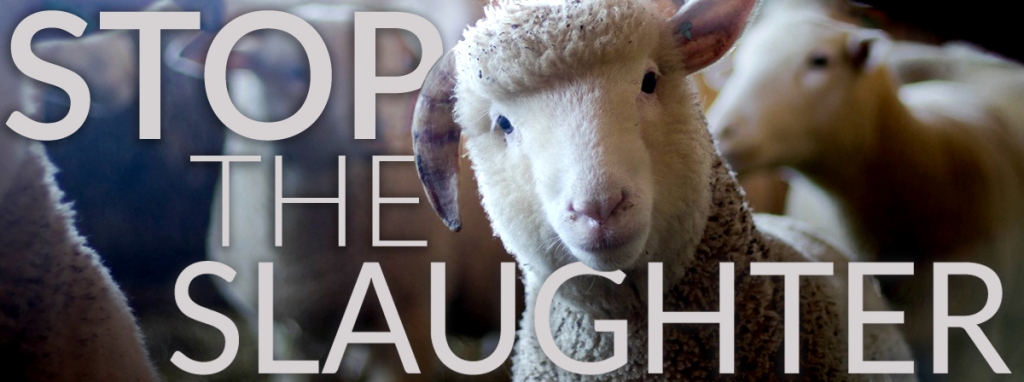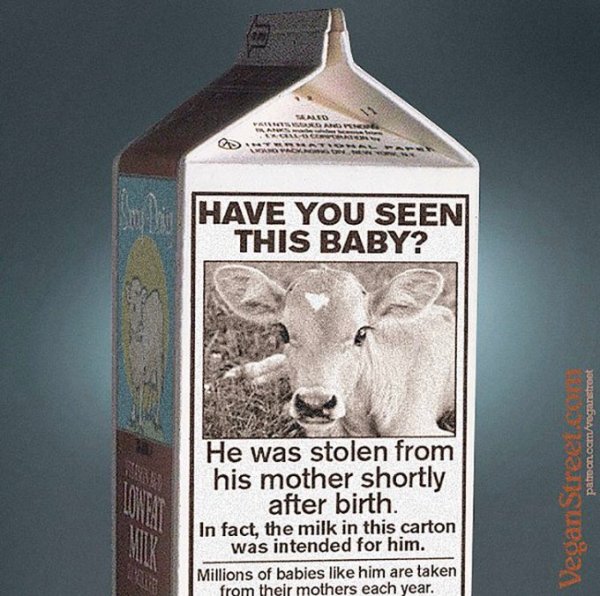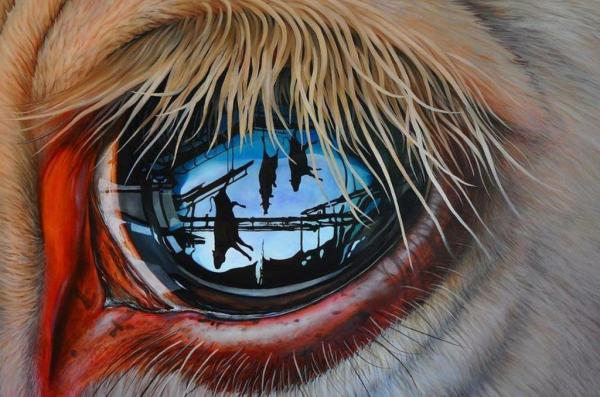City kids get lesson in bacon, bloodshed. Or… how to appreciate murder.
Editor’s Note: This is hideous, an abject display of arrogance and shame. Yeah, pat yourselves on the back for being so progressively thankful and righteous by exposing others to a live murder in a nurturing environment. These “wise” people honestly believe they are setting some respect standard in some contemporary therapeutic exercise in self-indulgence. Yes, this is for PEOPLE not the ANIMALS. Here’s a thought: set those standards higher and REFUSE to support, endorse, and promote the wasteful, unethical, and barbaric murder of sentient animals! You think because you watch it in person you UNDERSTAND it? You think because people witness the deliberate murder of animals for their food in some field-trippy, adventurous atmosphere they can APPRECIATE it? Why not appreciate life? Throughout this site you can see numerous images and videos demonstrating the blood and savagery inherent in animal food, fur, fun, and pharma, for educational purposes. I wholly believe that many people are visual and can understand better by viewing images. But to deliberately engage in murder meant to promote APPRECIATION in a loving atmosphere that establishes a kind and enriching experience rather than OBJECTION is ridiculously speciesist and abusive; I’m pretty certain children don’t need to be in an auto accident to appreciate the dangers of not wearing a seat belt.
This is wrong, I would never raise a child to appreciate animals by engaging in their murder: how does this carnival of death do anything but challenge the fundamentally insidious social nature/acceptance of killing when mommy and daddy are laughing in the splendor of the weather and Timmy and Susie dancing in the wheat? Appreciating animals by rejecting their torture and murder is compassionate. Exposing people to some self-serving theatrical demonstration of “where your food comes from” benefits humans, who now can arrogantly claim “understanding” and “appreciation” and can squelch those twinges of unethical disquiet in an utterly anthropocentric manner that does NOTHING for the animals.
You want children to appreciate food? Here’s a thought: teach them to appreciate life instead or take them to an orange grove. And don’t retort with the ridiculous validation that some may become veg*n as the result, that’s what vids and pics and books and education are for: taking children to Farmer Ted’s to witness murder while playing hopscotch and checkers in the sun is not an activity encouraging epiphany, introspection, or understanding, it’s a ludicrous expression of egocentrism, conforming the world to YOU and YOUR definition of appreciation while animals are murdered in the Sunny Patch of happiness. Why do you think McDonald’s have fun lands and bouncy kingdoms? Murder is more palatable when made to be fluffy and fun, with human animals as king and non-human animals as commodified subjects, congratulations for taking that speciesist route rife with indulgent banalities meant to benefit you. You only succeed in exploiting animals even more, but now with socially-rewarding impunity. Even hell can look beautiful if you make it fun and encouraged by mommy and daddy. But here’s the thing: Murder Is Murder. Regardless of props.
Because here is where parents – the hunters, the zoo and circus patrons, the revelers of murderous farm carnivals – get it wrong Every Single Time: you do not teach children to respect and appreciate life by participating in its exploitation, suffering, and murder. You teach children to respect and appreciate life by recognizing its sentience and rejecting YOUR selfish definition of such. There can be no respect of exploitation and death, the victims are the animals. Every time. And as long as they are the nonconsenting victims, you are nothing but the murderous perpetrators attempting to validate it as wholesome, respectful, and humane.
Next time take them to an animal shelter to HELP rather than KILL. Next time help them appreciate LIFE by SAVING IT rather than MURDERING IT. Or show them Meet Your Meat or Earthlings. On video. SR
From The Chicago Tribune
By Monica Eng
My 7-year-old loves bacon.
She loves it almost as much she loves pigs who are still alive.
And so our recent farm visit to witness a slaughter was not easy.
For years I’ve been talking to Miranda and her brother, Joe, about appreciating the sources of our food. I’ve introduced them to the farmers who provide our fruits, vegetables, milk, eggs and meat. They’ve met many cows, chickens and hogs who even more directly provide us with that food. But what they hadn’t seen was how those happy hogs become the ribs, bacon and sausages on our plates. Miranda agreed to see it; Joe stayed home.
We were at Faith’s Farm in Kankakee County, Ill., where owner Kim Snyder invited her friends from the city — chefs, farmers market managers, brewers, writers and food industry types — to meet her friends from the country — a butcher, a potter, many sustainable farmers and even a conventional rancher.
We’d come to tour her farm, cook together, talk and observe Snyder’s animals, from the frisky little piglets roaming the grounds to the unfortunate hog who would be butchered that day.
To my relief, I wasn’t the only one who brought a child. In fact, there were three 7-year-olds on the farm that day. Among them was Abigail Faith, Kim’s gentle daughter, who had seen slaughters before.
“Don’t worry,” she told Miranda. “It’s kind of gross, but then it’s over.”
Although my mom’s generation routinely took field trips to the Union Stockyards, today there’s little agreement on when it’s OK to let a child see the origins of her meat.
“You can’t do that to city kids,” my brother admonished. “They’re not used to it. It could really disturb them.” Numerous city friends echoed his views.
But when I mentioned those concerns to farmers at the event, they just shook their heads. “Where do city kids think their meat comes from?” one asked. “This is why people are so disconnected from their food.”
In Snyder’s kitchen, I chatted with Thomas Praire, a Frenchman who is interning on a Midwestern farm this summer. “I am 22, and I am not ready to see this,” he said in a thick Gallic accent. “It is horrible.”
“But if it’s that horrible to you, should you eat meat and cause it to happen?” I asked. “Shouldn’t you see and decide?”
Park Grill chef Bernie Laskowski was quietly cutting vegetables nearby and offered, “I don’t think everyone should see it. I just think they need to have respect for the meat and understand the sacrifice it entails.”
Laskowski also brought his kids. Older than the rest, they were by far the most philosophical of the bunch.
“I think it’s sad,” 12-year-old Sebastian said as we sat on hay bales watching the adults corral one of the Berkshire pigs from the field. “But we can’t have meat if we don’t do this. And at least he gets to live outside instead of a factory.” Indeed, only a tiny fraction of U.S. hogs are afforded outdoor lives and humane slaughter.
Still, 11-year-old Gabby spoke for many of us when she stared at the designated black pig and announced, “I wish bacon didn’t taste so good.”
Seven-year-old Kent was torn between his deep empathy for the pig “who didn’t do anything to anyone” and his fascination with its disassembled parts.
All of these kids were cool cucumbers compared with Miranda, who sat nervously on my lap squeezing my hand and asking: “So first they’ll shoot him in the head, right?”
“Right,” I said, just as a shot rang from the knock bolt and pierced the pig’s skull. The body continued to twitch as Sam Clark, the butcher, carried it over to a pit and sliced its neck, releasing a flood of red.
Miranda covered her eyes. One of the children gasped, “Oh my God.”
As the animal was bled, skinned and eviscerated before us, the children watched closely — all except Miranda, who wept into her hands, stole quick glances and turned her gaze to a group of concerned donkeys nearby.
When she finally returned her full gaze, she saw Clark lifting the carcass off the cradle as a last gush of blood fell to the ground. He headed for the cooler.
Everyone breathed a sigh of relief, and the kids ran off to resume their play, especially with the piglets.
Later they would talk about their sadness over the event, but also a new appreciation for the animals.
Like most meat eaters (including this one), they remain a bit conflicted — more conscious but not vegetarian.
Miranda was shocked by all the blood but said it’s “important for kids to understand that meat doesn’t grow from the ground or from holes at the store.”
So would she do it again? “No way,” she said. “But I think Joe should.”
RELATED:














































I’ve seen the programm.
They didn’t show fluffy little chicks ground alive to a pulp.
They didn’t show baby calves shot, being a dairy by-product and fed to hunting dogs.
They didn’t show piglets smashed against the wall
Don’t think I need to go on, do I.
I just hope they don’t wear fur-trimmed clothing because they won’t show cats, dogs, raccoons, oppossums (tasmania) and rabbits skinned alive.
How nice it is to be nice, or is it?
How nice it is to create the ideal educated consumer…………….
LikeLike
It starts when we, as adults, disrespect, neglect, abuse or harm an animal. By doing so, we are unknowingly guiding children onto a slippery slope that can ultimately affect their mental health. The process begins with desensitisation or loss of feeling, whereby children become able to witness the neglect, hurting, harming or killing of an animal and yet remain indifferent.
The second step is when children become accustomed to the pain and suffering they witness, and become habituated. Habituation to neglect and cruelty means that it has become a routine part of their lives.
Importantly, desensitisation directly opposes the crucial development in early childhood of empathy. Understanding the nature of empathy is critical to our understanding of how animal cruelty affects children. Empathy is the ability to feel with another person. It is the precursor to sympathy and sympathetic behaviour. Social workers and psychologists regard empathy as an indicator of healthy emotional development in children and adults. It is believed to be the vital ‘ingredient’ upon which socially competent, cohesive, integrated, cooperative, sustainable and peaceful communities are built.
..’
http://humane-education.org.za/view/blog/childhood-development-impaired-by-animal-abuse/
LikeLike
I, a happy vegan – but it was not always so. I grew up on a farm where we slaughtered and processed our own meat. I finally find more satisfaction in letting animals live than in eating their flesh.
…but this was a process. Until everyone comes to the same understanding, animals will be killed for human consumption. That is a fact. As long as that reality persists, I think that it fitting that those who still feed on the flesh of others should not be sheltered from the realities of their choices. They should have to see the costs of their indulgence.
LikeLike
THIS IS NO DIFFERENT THEN THE PROGRA WHERE THEY ALLOW ELEMENTARY AGE CHILDREN TO RAISE A SHEEP. AT THE END OF THE “STUDY” THEY ARE ALL GIVEN THE DESICION. DOES THIS SHEEP GET TO LIVE OUT ITS DAYS ON A NO KILL FARM… OR DOES IT GO TO SLAUGHTER.. SURPRIZINGLY MOST PICK SLAUGHTER.. THE PROGRAM ENDS. WHY DO THEY END IT THEIR? IF YOU ARE GIVEN THAT CHOICE, I BELIEVE YOU UST THEN SEE WHAT THE COMPLETE ENDING IS AND MAYBE EVEN EAT OF IT…… I THINK CHOICES WOULD BE MADE W/ MORE FEELING, AND REAL THOUGHT. THESE ARE AFTER ALL KIDS. THEY’VE NO IDEA WHAT HAPPENS THEN. ITS NOT “COOL” OR WHATEVER.. ITS SAD AND HORRIBLE AND IF THEY GET TO CHOOSE THEY NEED TO SEE IT THRU. RIGHT DOWN TO EATING THE FLESH OF THE ONCE SWEET LIL LAMB THEY RAISED.. MY OPPINION. BUT I THINK IT’D CHANGE MANY MINDS…..
LikeLike
Hey there are using WordPress for your blog platform? I’m new to the blog world but I’m trying to get started and set
up my own. Do you require any html coding expertise to make your own blog?
Any help would be really appreciated!
LikeLike